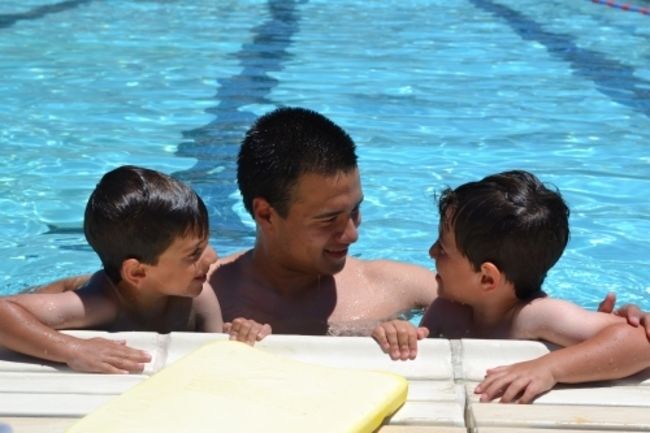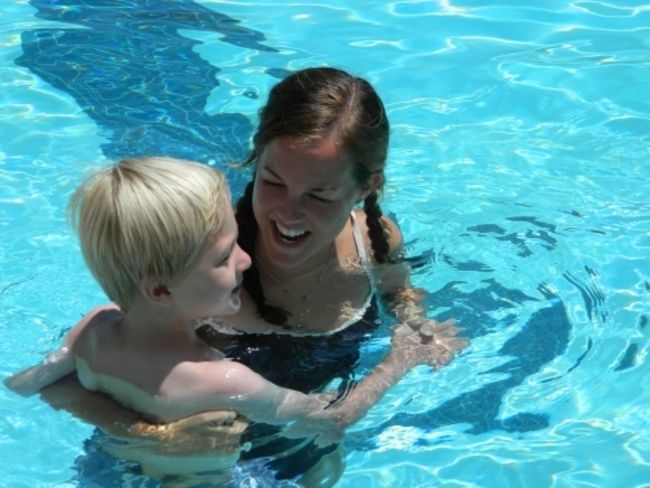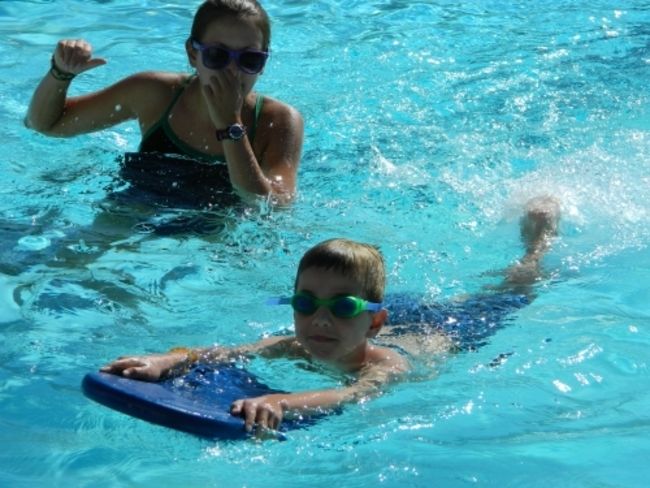 A child’s first time in a pool can be a fun and exciting experience, but some children may be too frightened or reluctant to go in the water. Helping kids overcome their fear of water and not be scared to try swimming is something we face often at camp. Although kids may have a lot of fun in the bathtub, graduating to a large swimming pool or natural body of water may be overwhelming. There are a few simple ways of helping children get comfortable being in and around water and enabling kids to achieve this level of comfort is an important step in helping them become water safe.
A child’s first time in a pool can be a fun and exciting experience, but some children may be too frightened or reluctant to go in the water. Helping kids overcome their fear of water and not be scared to try swimming is something we face often at camp. Although kids may have a lot of fun in the bathtub, graduating to a large swimming pool or natural body of water may be overwhelming. There are a few simple ways of helping children get comfortable being in and around water and enabling kids to achieve this level of comfort is an important step in helping them become water safe.
At Camp, we like to use a 4 step approach to help a reluctant or first time swimmer. We allow children to observe the water and others in water, we use reassurance to make sure they feel safe and comfortable, we offer words of encouragment and importantly we congratulate them when they make progressive steps. Combined this all helps to grow the confidence of a young swimmer. It is extremely important to take everything one small step at a time.
At the observation stage your child may want to simply observe the pool and see what other people are doing. At this stage, it is important to stay with your child and encourage them to sit on the edge of the pool with their feet in the water. Since role modeling is the most effective way for children to learn, make sure that you put your feet in as well so the child can follow your lead.
Once a child has their feet in the water getting in the pool together and standing close by to let kids kick their feet and splash is a fun way to help them continue to gain confidence. It is also helpful to show kids that you can touch the bottom and to reassure them that you we will hold them while they are in the water, until they are ready to let go. It is important to encourage and congratulate kids as they complete each step to get a little closer to being completely comfortable with the water.
 If a child is still nervous about getting completely underwater, using floating toys like rubber ducks or kickboards can be used as added positive reinforcement. Sometimes figuring out what a child’s specific fear is and addressing it without minimizing it can help overcome it. Once you identify the specific fear, you may need to address it out loud. If for example, your child’s fear is putting his head completely underwater, you may say “I see you are feeling afraid of putting your head underwater, but I would like you to try holding on to the edge of the pool.” When your child is ready, help him put his body in the pool and make sure to hold him so he feels safe and secure. However, do not surprise kids by submerging them in the water with you as you hold them, even if it’s just a quick bob in the water. This may do more harm than good, as it may increase their fear and make them more reluctant to go in the water.
If a child is still nervous about getting completely underwater, using floating toys like rubber ducks or kickboards can be used as added positive reinforcement. Sometimes figuring out what a child’s specific fear is and addressing it without minimizing it can help overcome it. Once you identify the specific fear, you may need to address it out loud. If for example, your child’s fear is putting his head completely underwater, you may say “I see you are feeling afraid of putting your head underwater, but I would like you to try holding on to the edge of the pool.” When your child is ready, help him put his body in the pool and make sure to hold him so he feels safe and secure. However, do not surprise kids by submerging them in the water with you as you hold them, even if it’s just a quick bob in the water. This may do more harm than good, as it may increase their fear and make them more reluctant to go in the water.
In order to help kids gain enough confidence to put their entire head in the water, it helps to do it step by step using fun techniques like “listening to the fish”. Using this technique helps kids put their ears in the water. Similarly, asking kids to “talk to the fish” (blowing bubbles in the water) encourages them to put their mouth and nose in the water. Remember how big of a step it is for kids to submerge their face; do your best not to rush them through all these steps at once.
 Other great tools that help move on to the next basic skill level are diving rings. It is easy to find rings or other fun shapes that will sink to the bottom of the pool that will encourage your child to go completely under water. As kids surpass this level, it is necessary to talk about water safety and the importance of waiting for adult supervision before they enter the water. Using these steps and being patient and supportive will help kids become water safe and ready to learn swimming skills in no time!
Other great tools that help move on to the next basic skill level are diving rings. It is easy to find rings or other fun shapes that will sink to the bottom of the pool that will encourage your child to go completely under water. As kids surpass this level, it is necessary to talk about water safety and the importance of waiting for adult supervision before they enter the water. Using these steps and being patient and supportive will help kids become water safe and ready to learn swimming skills in no time!
See more about Roughing It Swim Lessons and our Water Readiness Program.



